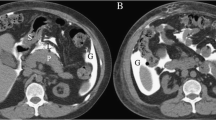Abstract
Purpose: To investigate the spectrum of US findings as encountered in a consecutive series of patients referred with clinically suspected gastrointestinal perforation. Methods: Seventy-two consecutive patients (mean age: 42.9 years) with clinically suspected gastrointestinal perforation were prospectively examined with abdominal ultrasound (US). The US examinations were all performed by a certified senior radiologist, who was blind to other imaging findings. Patients were screened for the presence of free intraperitoneal gas (characteristic comet-tail artifacts, ring-down artifacts, and the “shifting phenomenon” were our diagnostic indicators of pneumoperitoneum). Other signs potentially suggestive of gastrointestinal perforation were also looked for, including free intraperitoneal fluid, thickening of bowel walls, gallbladder walls, gastric walls, or duodenal walls, or local peritoneal inflammation. Patients with equivocal or inconclusive findings on US were submitted to abdominal computed tomography (CT) 10–15 min after US examinations. Results: Of the 72 patients prospectively examined by US, 63 (87.5 %) underwent subsequent emergent surgery within next 2 days. A gastrointestinal perforation was found in all the 63 patients referred for operative treatment: overall, 41 gastroduodenal and 22 intestinal perforations were found. On US, in the 41 patients with surgically proven gastroduodenal perforation, the most common finding was free intraperitoneal gas (28/41, 68.3 %). The 13/41 patients (31.7 %) without evidence of free gas on US underwent preoperative abdominal CT assessment, which allowed the correct diagnosis of gastroduodenal perforation in 12/13 cases. In the 22 patients with surgically proven intestinal perforation the most common finding detected on US was free intraperitoneal fluid (14/22, 63.6 %); sonographic evidence of free intraperitoneal gas was seen in only 8/22 patients (36.4 %). The 14/22 patients (63.6 %) without free gas on US underwent preoperative abdominal CT assessment, which allowed the diagnosis of intestinal perforation in 12/14 cases. Conclusion: US examinations allow very rapid screening of patients referred with clinically suspected gastrointestinal perforation and for triage of patients who are to undergo more invasive imaging tests.
Similar content being viewed by others
Author information
Authors and Affiliations
Rights and permissions
About this article
Cite this article
Pinto, F., Scaglione, M., Pinto, A. et al. Gastrointestinal perforation: ultrasound diagnosis. Emergency Radiology 7, 263–267 (2000). https://doi.org/10.1007/PL00011838
Issue Date:
DOI: https://doi.org/10.1007/PL00011838




